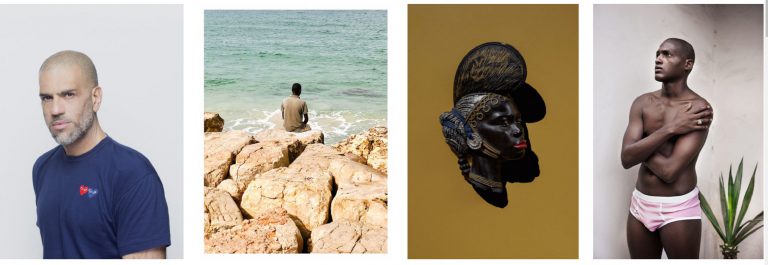By Katy Donoghue
David Adika has always been attracted to objects. Early on, they were artifacts or vases in his childhood home. Today, they are figurines found in flea markets, like those seen in his current solo show at Braverman Gallery in Tel Aviv, “Black Market,” viewable online here. Adika is well aware that his subjects—whether people or things—carry a particular culture and class affiliation.
The Tel Aviv–based photographer has been wielding a camera since age 20, and now holds the position of chair of the photography department at Bezalel Academy of Arts and Design, Jerusalem.
Recently, we checked in with Adika recently to see how he is doing while in confinement. “I am doing well. Working from home, supervising the ‘new curriculum’ for the Photography Department in Bezalel Academy in Jerusalem. We decided to teach from afar as much as possible, mainly to keep our students motivated in creating. This pandemic put us in a very unique situation and under quarantine, we are heavily exposed to press and communication, statistics, graphs, but there is a lack of image,” he said. “I think as creators, and especially as photographers, we are required to show responsibility and to shape the image of the present era.”
Whitewall spoke with Adika for our spring 2020 Art Issue about his need to capture beautiful moments.
WHITEWALL: You’ve described your practice as a by-product of the reality of your life. Have you always created from the personal?
DAVID ADIKA: As an artist, I believe I cannot create from a place that is not personal. When I talk about photography or think about photography, I think of a point of view. Photography as a medium is inherently infused with reality, even when it tries to slip away from it, conceal, rewrite, or intensify it. Photography is always already a form of reality.
WW: What draws you to working with objects that are considered “kitsch”?
DA: More than a mere aesthetic classification, the standard definition of “kitsch” is embedded in the question of class. The objects I refer to in my work carry a particular character, culture, and class affiliation. They are not necessarily part of the visual vocabulary of the art world nor of Western modernism. In my early works, I photographed artifacts and souvenirs I took from my parents’ home in Jerusalem. This action has expanded.
Nowadays, I select objects and artifacts from the domestic display, and against the backdrop of photography and installation practices, I seek to treat them differently. I move, alter, place, and rearrange objects not according to any personal taste but as an attempt to invoke questions on cultural, social, and a class phenomenon. “Kitsch,” therefore, is only one option for such objects.
WW: Does your approach change between capturing portraits, objects, or places?
DA: Photography is the way to tell a story to connect to people, biographies, and narratives; it is how I know people and how I understand the culture. I care about people and people’s belongings and objects. The move between portrait to objects is natural to me. I was once told that I had been looking at people like objects and on objects like people. Perhaps there is a general statement to make here about objectification and personification. This tension, no doubt, interests me.
WW: What was the starting point for your current show, “Black Market” at Braverman Gallery in Tel Aviv?
DA: The installation includes photographs of figurines created in Israel during the 1960s and 1970s in two local workshops: “Mizrachi” and “Khakoon.” The figurines depict portraits, mainly heads, of black figures, apparently a postcolonial reminder of Israel’s cultural history. The 1950s to 1960s in Israel are fascinating to me. These were the decades when secular, Zionist, eclectic, and mixture culture existed—examining these decades from the perspective of today reveals local and international social processes.
WW: Tell us about your studio and process.
DA: My studio routine is perhaps the most inconsistent thing in my life at the moment. As a photographer and as an artist, I look for opportunities. Sometimes I’m a hunter, and sometimes I’m a flâneur. In that sense, every encounter, every visit, every interaction, every experience, personal or not, going into my virtual space of thoughts and ideas. Sometimes coming to the studio when I am already at the end of the process evokes intense and unconventional work, too. My studio space is a cozy space with a high ceiling and lots of daylight. I store in the studio objects, paintings, books, and works. When I am at the studio, I usually take pictures, meeting people, and make sketches.
WW: What kinds of conversations are you having right now among your creative community in Tel Aviv?
DA: When I chose photography, I wanted to stand at the intersection of all other media that correspond with photography, and photography refers to all of them. Photography, I think, expands minds, as it allows one to be part of a large, diverse creative community. The creative community here in Israel/Palestine is fascinating. Luckily, in the past decade, the artistic community has become much more varied. This diversity has a direct impact on the discursive, aesthetic, and political questions that hover nowadays. The student body I am in daily contact with is much more diverse, too. There is a multitude of cultures and identities here, an ongoing conflict, and a reality that is impossible sometimes. These conditions take us all off balance and from the comfort zone, as they are challenging as life itself, but they also nourish the creative process.

Sunday
Monday
Tue – Thu
Friday
Saturday
Closed
By appointment only
11:00 – 18:00
11:00 – 14:00
11:00 – 14:00
Design by The-Studio
Code By Haker Design
Sunday
Monday
Tue – Thu
Friday
Saturday
Closed
By appointment only
11:00 – 16:00
11:00 – 14:00
Closed